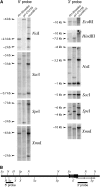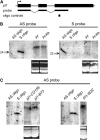Multiple trans-sensing interactions affect meiotically heritable epigenetic states at the maize pl1 locus
- PMID: 17435245
- PMCID: PMC1894611
- DOI: 10.1534/genetics.107.072496
Multiple trans-sensing interactions affect meiotically heritable epigenetic states at the maize pl1 locus
Abstract
Interactions between specific maize purple plant1 (pl1) alleles result in heritable changes of gene regulation that are manifested as differences in anthocyanin pigmentation. Transcriptionally repressed states of Pl1-Rhoades alleles (termed Pl') are remarkably stable and invariably facilitate heritable changes of highly expressed states (termed Pl-Rh) in Pl'/Pl-Rh plants. However, Pl' can revert to Pl-Rh when hemizygous, when heterozygous with pl1 alleles other than Pl1-Rhoades, or in the absence of trans-acting factors required to maintain repressed states. Cis-linked features of Pl1-Rhoades responsible for these trans-sensing behaviors remain unknown. Here, genetic tests of a pl1 allelic series identify two potentially separate cis-linked features: one facilitating repression of Pl-Rh and another stabilizing Pl' in trans. Neither function is affected in ethyl-methanesulfonate-induced Pl1-Rhoades derivatives that produce truncated PL1 peptides, indicating that PL1 is unlikely to mediate trans interactions. Both functions, however, are impaired in a spontaneous Pl1-Rhoades derivative that fails to produce detectable pl1 RNA. Pl'-like states can also repress expression of a pl1-W22 allele, but this repression is not meiotically heritable. As the Pl' state is not associated with unique small RNA species representing the pl1-coding region, the available data suggest that interactions between elements required for transcription underlie Pl1-Rhoades epigenetic behaviors.
Figures





Similar articles
-
Trans-Homolog Interactions Facilitating Paramutation in Maize.Plant Physiol. 2015 Aug;168(4):1226-36. doi: 10.1104/pp.15.00591. Epub 2015 Jul 6. Plant Physiol. 2015. PMID: 26149572 Free PMC article. Review.
-
Genetic factors required to maintain repression of a paramutagenic maize pl1 allele.Genetics. 2001 Jan;157(1):369-78. doi: 10.1093/genetics/157.1.369. Genetics. 2001. PMID: 11139517 Free PMC article.
-
Epigenetic allelic states of a maize transcriptional regulatory locus exhibit overdominant gene action.Genetics. 1998 Oct;150(2):891-7. doi: 10.1093/genetics/150.2.891. Genetics. 1998. PMID: 9755217 Free PMC article.
-
Allelic interactions heritably alter the activity of a metastable maize pl allele.Genetics. 1995 Oct;141(2):709-19. doi: 10.1093/genetics/141.2.709. Genetics. 1995. PMID: 8647404 Free PMC article.
-
Paramutation: a process for acquiring trans-generational regulatory states.Curr Opin Plant Biol. 2011 Apr;14(2):210-6. doi: 10.1016/j.pbi.2011.02.005. Epub 2011 Mar 17. Curr Opin Plant Biol. 2011. PMID: 21420347 Review.
Cited by
-
required to maintain repression2 is a novel protein that facilitates locus-specific paramutation in maize.Plant Cell. 2012 May;24(5):1761-75. doi: 10.1105/tpc.112.097618. Epub 2012 May 4. Plant Cell. 2012. PMID: 22562610 Free PMC article.
-
Maize RNA polymerase IV defines trans-generational epigenetic variation.Plant Cell. 2013 Mar;25(3):808-19. doi: 10.1105/tpc.112.107680. Epub 2013 Mar 19. Plant Cell. 2013. PMID: 23512852 Free PMC article.
-
Genetic control of non-genetic inheritance in mammals: state-of-the-art and perspectives.Mamm Genome. 2020 Jun;31(5-6):146-156. doi: 10.1007/s00335-020-09841-5. Epub 2020 Jun 11. Mamm Genome. 2020. PMID: 32529318 Free PMC article. Review.
-
Paramutation and related phenomena in diverse species.Nat Rev Genet. 2017 Jan;18(1):5-23. doi: 10.1038/nrg.2016.115. Epub 2016 Oct 17. Nat Rev Genet. 2017. PMID: 27748375 Review.
-
Trans-Homolog Interactions Facilitating Paramutation in Maize.Plant Physiol. 2015 Aug;168(4):1226-36. doi: 10.1104/pp.15.00591. Epub 2015 Jul 6. Plant Physiol. 2015. PMID: 26149572 Free PMC article. Review.
References
-
- Alleman, M., L. Sidorenko, K. McGinnis, V. Seshadri, J. E. Dorweiler et al., 2006. An RNA-dependent RNA polymerase is required for paramutation in maize. Nature 442 295–298. - PubMed
-
- Brink, R. A., 1964. Genetic repression of R action in maize, pp. 183–230 in The Role of Chromosomes in Development, edited by M. Locke. Academic Press, New York.
-
- Brodersen, P., and O. Voinnet, 2006. The diversity of RNA silencing pathways in plants. Trends Genet. 22 268–280. - PubMed
Publication types
MeSH terms
Substances
LinkOut - more resources
Full Text Sources
Other Literature Sources
Research Materials

